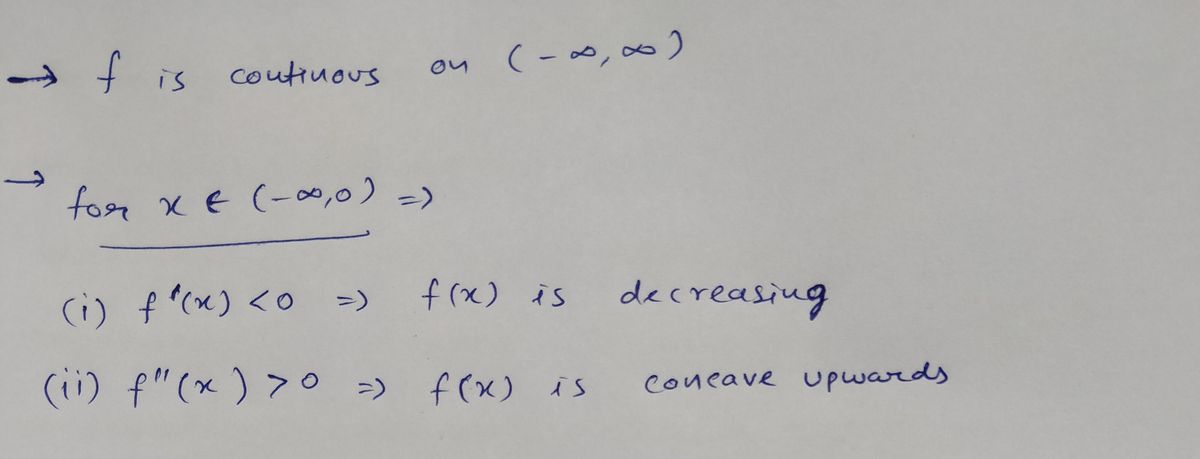Calculus: Early Transcendentals
8th Edition
ISBN:9781285741550
Author:James Stewart
Publisher:James Stewart
Chapter1: Functions And Models
Section: Chapter Questions
Problem 1RCC: (a) What is a function? What are its domain and range? (b) What is the graph of a function? (c) How...
Related questions
Question

Transcribed Image Text:**Question**
Sketch a graph of a function \( f \) that is continuous on \((-\infty, \infty)\) such that:
- \(f'(x) < 0\) and \(f''(x) > 0\) on \((-\infty, 0)\);
- \(f'(x) < 0\) and \(f''(x) < 0\) on \((0, \infty)\).
**Explanation**
Given these conditions:
1. **On the interval \((-\infty, 0)\):**
- \(f'(x) < 0\) indicates that the function \( f(x) \) is decreasing.
- \(f''(x) > 0\) means that the function is concave up (the slope is increasing).
2. **On the interval \((0, \infty)\):**
- \(f'(x) < 0\) indicates that the function \( f(x) \) is decreasing.
- \(f''(x) < 0\) means that the function is concave down (the slope is decreasing).
The graph of such a function would show a continuous curve that decreases as it moves from left to right across the entire number line, with a change in concavity at \(x = 0\). On the left side of the y-axis, the curve would start decreasing but concaving upwards, and on the right side, it would continue to decrease but now concaving downwards.
Expert Solution
Step 1

Step by step
Solved in 2 steps with 2 images

Recommended textbooks for you

Calculus: Early Transcendentals
Calculus
ISBN:
9781285741550
Author:
James Stewart
Publisher:
Cengage Learning

Thomas' Calculus (14th Edition)
Calculus
ISBN:
9780134438986
Author:
Joel R. Hass, Christopher E. Heil, Maurice D. Weir
Publisher:
PEARSON

Calculus: Early Transcendentals (3rd Edition)
Calculus
ISBN:
9780134763644
Author:
William L. Briggs, Lyle Cochran, Bernard Gillett, Eric Schulz
Publisher:
PEARSON

Calculus: Early Transcendentals
Calculus
ISBN:
9781285741550
Author:
James Stewart
Publisher:
Cengage Learning

Thomas' Calculus (14th Edition)
Calculus
ISBN:
9780134438986
Author:
Joel R. Hass, Christopher E. Heil, Maurice D. Weir
Publisher:
PEARSON

Calculus: Early Transcendentals (3rd Edition)
Calculus
ISBN:
9780134763644
Author:
William L. Briggs, Lyle Cochran, Bernard Gillett, Eric Schulz
Publisher:
PEARSON

Calculus: Early Transcendentals
Calculus
ISBN:
9781319050740
Author:
Jon Rogawski, Colin Adams, Robert Franzosa
Publisher:
W. H. Freeman


Calculus: Early Transcendental Functions
Calculus
ISBN:
9781337552516
Author:
Ron Larson, Bruce H. Edwards
Publisher:
Cengage Learning